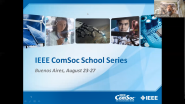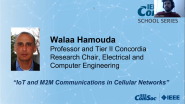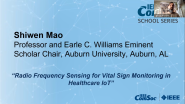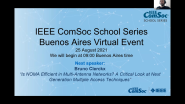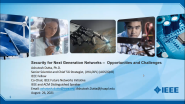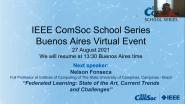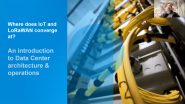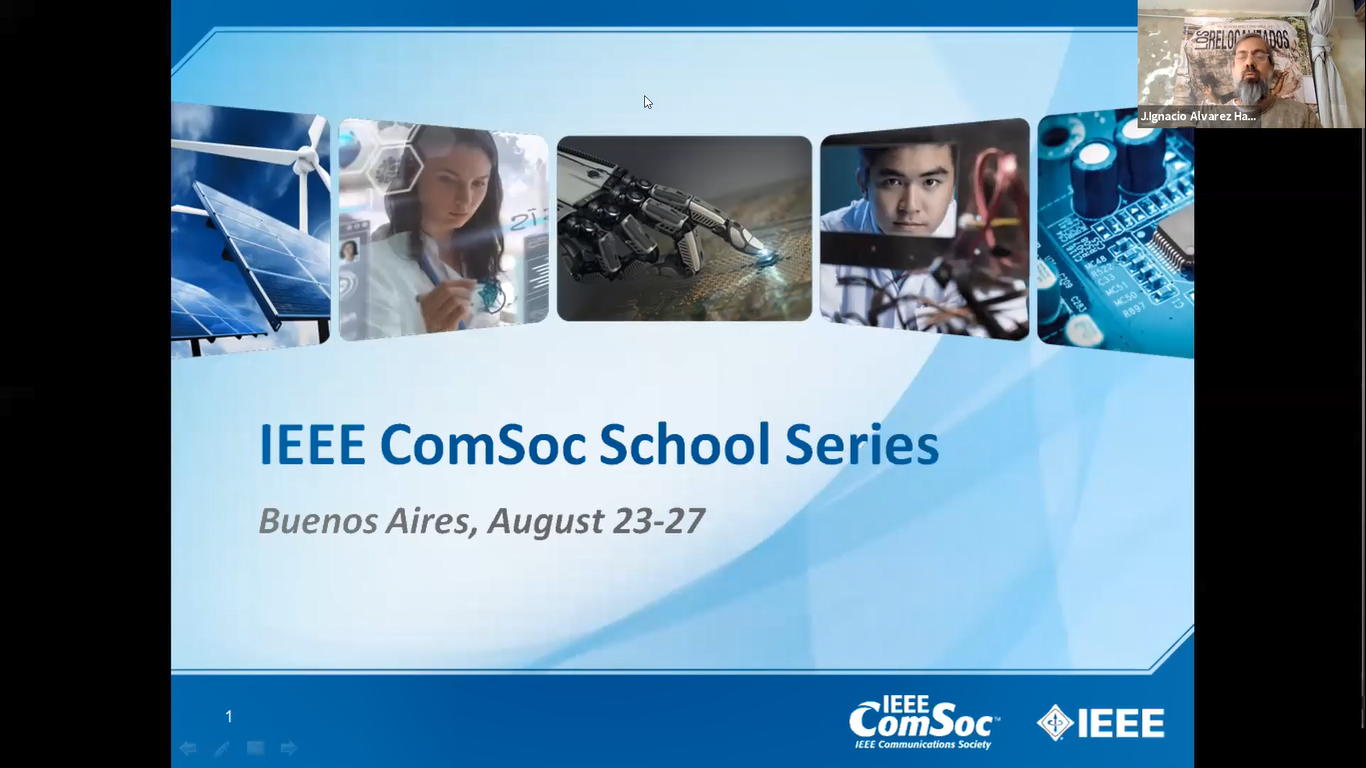
- IEEE MemberUS $4.99
- Society MemberUS $0.00
- IEEE Student MemberUS $4.99
- Non-IEEE MemberUS $9.99
- IEEE MemberUS $4.99
- Society MemberUS $0.00
- IEEE Student MemberUS $4.99
- Non-IEEE MemberUS $9.99
IoT and M2M Communications in Cellular Networks
In this seminar, we will present the recent and future Machine Type Communications (MTC) advances and its requirements on cellular networks such as low-power, low-cost, narrow band, and extended coverage. To support these features, the 3GPP LTE-A introduced a new user equipment (UE) category, namely CAT-M1 raising new challenges for the system designers. The talk is focused on the current technologies that support IoT and machine-to-machine communications. Furthermore, application of cognitive radio technology to IoT is proposed and discussed in the context of existing cellular networks. The challenges and future research directions in IoT and its application to wireless communications are presented.
- IEEE MemberUS $4.99
- Society MemberUS $0.00
- IEEE Student MemberUS $4.99
- Non-IEEE MemberUS $9.99
Radio Frequency Sensing for Vital Sign Monitoring in Healthcare IoT
Vital signs, such as breathing and heartbeat, are useful information for health monitoring since such signals provide important clues of medical conditions. Effective solutions are needed to provide contact-free, easy deployment, low-cost, and long-term vital sign monitoring. Exploiting wireless signals for contact-free vital sign monitoring will be an important part of the future healthcare Internet of Things (IoT). In this talk, we present our recent work on contact-free vital sign monitoring. The first part is to exploit channel state information (CSI) phase difference data to monitor breathing and heartbeat with commodity WiFi devices. We will present PhaseBeat, a discrete wavelet transform based design, and TensorBeat, a tensor decomposition based design, as well as our experimental study to validate their performance. The second part of this talk is to exploit a 20KHz ultrasound signal for breathing rate detection. We will present our smartphone App based implementation. The third part of the talk is on radio-frequency identification (RFID) based vital sign monitoring, where RFID tags are used as wearable sensors attached to the human body. We will investigate the various technical challenges on fully exploiting RFID for vital sign monitoring and human activity recognition and tracking, and then review several of our recent works on RFID based human vital sign monitoring, drowsy driving detection, and 3D human pose monitoring and tracking. Our experimental study shows that the proposed systems can achieve high accuracy under different environments for vital sign monitoring.
- IEEE MemberUS $4.99
- Society MemberUS $0.00
- IEEE Student MemberUS $4.99
- Non-IEEE MemberUS $9.99
Communication Models for Reconfigurable Intelligent Surfaces: From Electromagnetics to Programmable Wireless Environments
A reconfigurable intelligent surface (RIS) is an emerging technology that enables the control of the electromagnetic waves. An RIS is a thin sheet of electromagnetic material, which is made of many nearly passive scattering elements that are controlled through low cost and low power electronic circuits. By appropriately configuring the electronic circuits, different wave transformations can be realized. Recent research works have shown that RISs whose geometric size is sufficiently large can outperform other technologies, e.g., relays, at a reduced hardware and signal processing complexity, and can enhance the reliability of wireless links by reducing the fading severity. In addition, the achievable performance of RIS-assisted systems has been proved to be robust to various hardware impairments, e.g., the phase noise, which may further reduce the implementation cost. To quantify the performance gains offered by RISs in wireless networks, realistic communication models need to be employed. In this talk, we offer a critical appraisal of the communication models currently employed for analyzing the ultimate performance limits and for optimizing RIS-assisted wireless networks. Furthermore, we introduce a new tractable, electromagnetic-compliant, and circuit-based communication model for RIS-assisted transmission and discuss its applications to the modeling and optimization of wireless systems.
- IEEE MemberUS $4.99
- Society MemberUS $0.00
- IEEE Student MemberUS $4.99
- Non-IEEE MemberUS $9.99
Is NOMA Efficient in Multi-Antenna Networks? A Critical Look at Next Generation Multiple Access Techniques
There’s a large body of literature on downlink Non-Orthogonal Multiple Access (NOMA), employing superposition coding and Successive Interference Cancellation, in multi-antenna wireless networks. The benefits of NOMA over Orthogonal Multiple Access (OMA) have been highlighted. In this talk, we take a critical and fresh look at the downlink Next Generation Multiple Access literature. Instead of contrasting NOMA with OMA, we contrast NOMA with two other multiple access baselines. The first is conventional Multi-User Linear Precoding (MU–LP), as used in Space-Division Multiple Access (SDMA) and MIMO in 4G and 5G. The second, called Rate-Splitting Multiple Access (RSMA), is based on multi-antenna Rate-Splitting. It is also a non-orthogonal transmission strategy relying on SIC developed in the past few years in parallel and independently from NOMA. First, we highlight why NOMA is inefficient in multi-antenna settings based on basic multiplexing gain analysis. Second, we show that NOMA incurs a severe multiplexing gain loss despite an increased receiver complexity due to an inefficient use of SIC receivers. Third, we emphasize that much of the merits of NOMA are due to the constant comparison to OMA instead of comparing it to MU–LP and RS baselines. We then expose the pivotal design constraint that multi-antenna NOMA requires one user to fully decode the messages of the other users. This design constraint is responsible for the multiplexing gain erosion, rate and spectral efficiency loss, ineffectiveness to serve a large number of users, and inefficient use of SIC receivers in multi-antenna settings. Our analysis and simulation results confirm that NOMA should not be applied blindly to multi-antenna settings, highlight the scenarios where MU–LP outperforms NOMA and vice versa, and demonstrate the inefficiency, performance loss, and complexity disadvantages of NOMA compared to RSMA.
- IEEE MemberUS $4.99
- Society MemberUS $0.00
- IEEE Student MemberUS $4.99
- Non-IEEE MemberUS $9.99
Security for Next Generation Networks: Opportunities and Challenges
Software Defined Networking (SDN) and Network Function Virtualization (NFV) are the key pillars of future networks, including 5G and beyond that promise to support emerging applications such as enhanced mobile broadband, ultra-low latency, massive sensing type applications while providing the resiliency in the network. Service providers and other vertical industries (e.g., Connected Cars, IOT, eHealth) can leverage SDN/NFV to provide flexible and cost-effective service without compromising the end user quality of service (QoS). While NFV and SDN open up the door for flexible networks and rapid service creation, these also offer both security opportunities while also introducing additional challenges and complexities, in some cases. With the rapid proliferation of 4G and 5G networks, operators have now started the trial deployment of network function virtualization, especially with the introduction of various virtualized network elements in the access and core networks. This talk addresses evolution of cellular technologies towards 5G but largely focuses on various security challenges and opportunities introduced by SDN/NFV and 5G networks and enablers such as Hypervisor, Virtual Network Functions (VNFs), SDN controller, orchestrator, network slicing, cloud RAN, edge cloud, and security function virtualization. This talk introduces a threat taxonomy for 5G security from an end-to-end system perspective, potential threats introduced by these enablers, and associated mitigation techniques. At the same time, some of the opportunities introduced by these pillars are also discussed. This talk also highlights some of the ongoing activities within various standards communities including open source consortiums, large scale testbeds, and illustrates a few deployment use case scenarios for security.
- IEEE MemberUS $4.99
- Society MemberUS $0.00
- IEEE Student MemberUS $4.99
- Non-IEEE MemberUS $9.99
Dynamic Massive Access Optimization in Cellular IoT Networks
Cellular-based networks are expected to offer connectivity for massive Internet of Things (mIoT) systems. However, their Random Access CHannel (RACH) procedure suffers from unreliability, due to the collision from the simultaneous massive access. Despite that this collision problem has been treated in existing RACH schemes, these schemes usually organize IoT devices’ transmission and re-transmission along with fixed parameters, thus can hardly adapt to time-varying traffic patterns. Without adaptation, the RACH procedure easily suffers from high access delay, high energy consumption, or even access unavailability. In this talk, how to optimize the RACH procedure in real-time by maximizing a long-term hybrid multi-objective function, which consists of the number of access success devices, the average energy consumption, and the average access delay will be presented.
- IEEE MemberUS $4.99
- Society MemberUS $0.00
- IEEE Student MemberUS $4.99
- Non-IEEE MemberUS $9.99
Federated Learning: State of the Art, Current Trends and Challenges
It is estimated that the number of interconnected Internet of Things (IoT) devices and smartphones surpass 8 billion and that 800 Zeta Bytes of data worldwide will be generated by 2021. Moreover, the great potentiality of transforming these data into useful information by employing machine learning (ML) techniques have been widely demonstrated. However, ML processing and training of supervised learning models have been carried out in centralized data centers with massive processing power and storage.
Edge/fog computing has addressed the limitations of cloud computing, especially the provisioning of fast response time to applications with strict latency requirements. Besides, federated learning (FL) has enabled the distributed processing of machine learning models at the edge of the network and collaborative model training without exposing a user’s data.
In FL, distributed entities send their model updates, to an FL server for aggregation. The steps are repeated in multiple rounds until an acceptable accuracy level is achieved. FL brings numerous advantages, such as data privacy, efficient bandwidth usage, and low latency. However, as a technology still in its infancy, there are still many challenges to overcome. This talk will overview the federate learning technology state of the art and discuss the challenges its advancement faces.
- IEEE MemberUS $4.99
- Society MemberUS $0.00
- IEEE Student MemberUS $4.99
- Non-IEEE MemberUS $9.99
 Cart
Cart Create Account
Create Account Sign In
Sign In
